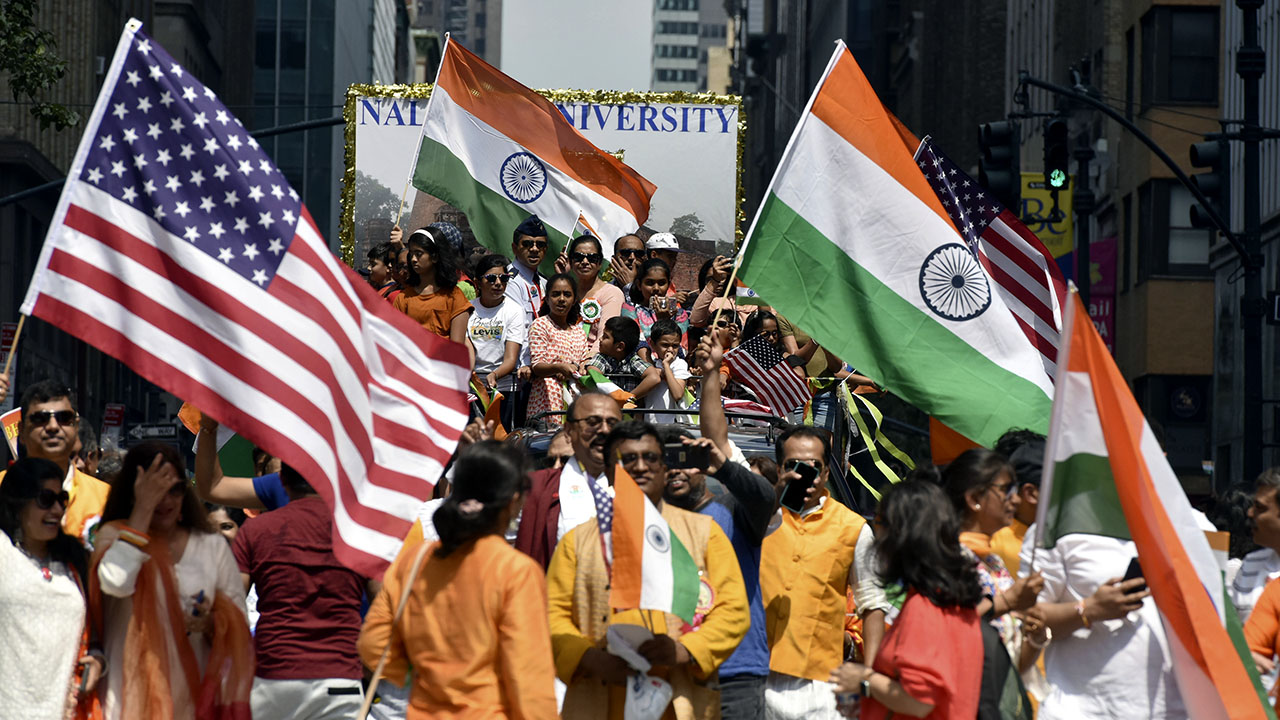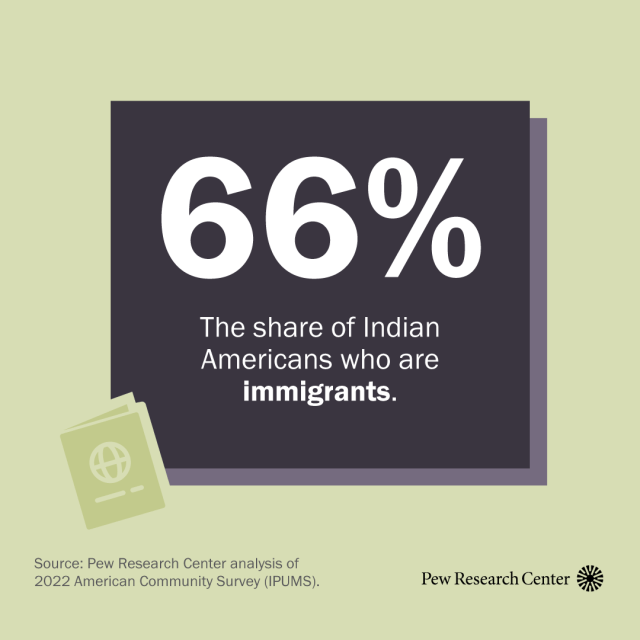Indian Americans:
A Survey Data Snapshot

These data snapshots are drawn from Pew Research Center’s in-depth research portfolio on Asian Americans. To learn more, visit our Asian Americans topic page.
The United States was home to about 4.8 million Indian Americans as of 2022, according to data from the U.S. Census Bureau. Indian Americans account for 20% of the nation’s Asian American population overall.

About two-thirds of Indian Americans (66%) are immigrants, while 34% are U.S. born. And around half of Indian Americans live in just four states: California (20%), Texas (12%), New Jersey (9%) and New York (7%).
The median income among Indian American households was $145,000 in 2022, meaning that half of households headed by an Indian American person earned more than that and half earned less. This is greater than the median household income among Asian Americans overall ($100,000).
Here’s a look at Indian Americans’ views and experiences across a range of topics, including how they think about their own identities, their opinions of the U.S. and India, and how they feel about achieving the American dream.
These findings are based on a nationally representative Pew Research Center survey of 7,006 Asian adults in the U.S. – including 897 Indian Americans – conducted in 2022 and 2023.
Identity
Indian Americans describe their identity in a variety of ways. Most say they most often describe themselves as either “Indian” (41%) or “Indian American” (21%). Another 10% usually call themselves “American,” 15% call themselves “Asian” or “Asian American,” and 9% say they most often describe their identity as “South Asian.”
Of the country’s six largest Asian origin groups, Indian adults are the most likely to say they typically describe themselves by their ethnicity alone, without the addition of “American.” Indian Americans are also more likely than the other large Asian origin groups to consider South Asians to be Asian: 91% say this is the case, compared with 67% of Asian Americans overall.
One-in-five Indian Americans say they’ve hidden a part of their heritage – such as cultural or religious practices – from people who are not Asian.
Views of the U.S. and India
The vast majority of Indian Americans (86%) have a favorable view of the U.S., including 56% who have a very favorable view. Indian Americans also have a largely positive opinion of their ancestral homeland: 76% see India favorably, including 51% who see it very favorably.
Still, most Indian adults in the U.S. say they would not move to India. About two-thirds (65%) say this, while 33% say they would move there. Among those who would move to India, about half (52%) say the main reason they’d do so is to be closer to family.
Achieving the American dream
Most Indian Americans feel that they’re either on their way to achieving the American dream (48%) or have already achieved it (27%). However, 23% say the American dream is out of reach for them.
Politics
A 68% majority of Indian American registered voters identify with or lean toward the Democratic Party, and 29% identify with or lean toward the Republican Party. Among Asian American registered voters overall, 62% are Democratic or Democratic-leaning and 34% are Republican or lean to the GOP.
About 46% of all Indian Americans – 2.2 million – were eligible to vote in 2022, according to Census Bureau data. This means they were at least 18 years old and a U.S. citizen through birth or naturalization. The share of Indian Americans who are eligible to vote is slightly lower than the country’s other large Asian origin groups, in part because they are more likely to be immigrants and may not hold U.S. citizenship.
Religion
About half of Indian Americans (48%) identify as Hindu. In total, two-thirds of Indian Americans say either that they are Hindu or that they identify with another religion but feel closely connected to Hinduism for other reasons, such as family background or culture.
Another 15% of Indian Americans identify as Christian, 15% are religiously unaffiliated and 8% are Muslim; 11% identify with some other faith.
Photo by Anthony Behar/Sipa via AP Images
This analysis is one in a seven-part series that explores the identities, views, attitudes and experiences of Asian Americans, including the six largest Asian origin groups in the U.S. In these analyses, Asian Americans include those who identify as Asian, either alone or in combination with other races or Hispanic ethnicity.
The six Asian origin groups highlighted in this series – Chinese, Filipino, Indian, Japanese, Korean and Vietnamese Americans – include those who identify with one Asian origin only, either alone or in combination with a non-Asian race or ethnicity. In this series, Chinese adults do not include those who self-identify as Taiwanese. Other Pew Research Center analyses exploring the attitudes and characteristics of Asian origin groups may use different definitions and therefore may not be directly comparable.
This analysis is based on two data sources. The first is Pew Research Center’s 2022-23 survey of Asian American adults, conducted from July 2022 to January 2023 in six languages among 7,006 respondents. The Center recruited a large sample to examine the diversity of the U.S. Asian population, with oversamples of the Chinese, Filipino, Indian, Korean and Vietnamese populations. These are the five largest origin groups among Asian Americans. The survey also includes a large enough sample of self-identified Japanese adults to make certain findings about them reportable. For more details, read the methodology.
The second data source is the U.S. Census Bureau’s 2022 American Community Survey (ACS) provided through Integrated Public Use Microdata Series (IPUMS) from the University of Minnesota.
Pew Research Center is a subsidiary of The Pew Charitable Trusts, its primary funder. The Center’s Asian American portfolio was funded by The Pew Charitable Trusts, with generous support from The Asian American Foundation; Chan Zuckerberg Initiative DAF, an advised fund of the Silicon Valley Community Foundation; the Robert Wood Johnson Foundation; the Henry Luce Foundation; the Doris Duke Foundation; The Wallace H. Coulter Foundation; The Dirk and Charlene Kabcenell Foundation; The Long Family Foundation; Lu-Hebert Fund; Gee Family Foundation; Joseph Cotchett; the Julian Abdey and Sabrina Moyle Charitable Fund; and Nanci Nishimura.
We would also like to thank the Leaders Forum for its thoughtful leadership and valuable assistance in helping make this survey possible.
The strategic communications campaign used to promote the research was made possible with generous support from the Doris Duke Foundation.